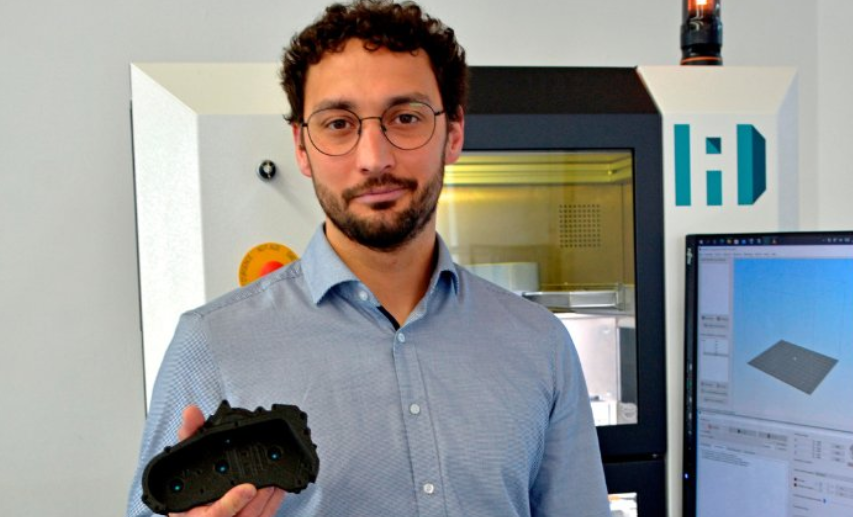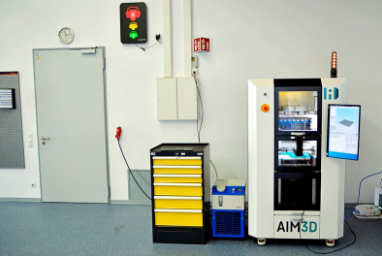Germany-based Naddcon research and development center has combined AIM3D’s ExAM 255 3D printer with Siemens NX software allowing Siemens NX users to directly control and operate the 3D printer from the software.
“Our digital NX approach is intended to better exploit the CEM machine technology from a design and production preparation point of view. There is considerable potential here for free-form surfaces, that is, real 3D contours, but also bionic design strategies,” says Sebastian Kallenberg, Application and Development Engineer at Naddcon.
AIM3D is a German multi-material 3D printing company. AIM3D says the ExAM 255 3D printer is a pellet-based, or granulate-based, material extrusion printer. Siemens NX offers a range of solutions such as CAM, CAD, and CAE. Naddcon has made the ExAM 255 accessible as a digital machining system by integrating it into the NX environment, allowing for more streamlined 3D CEM operations. AIM3D believes that this integration with NX is just one of the “numerous” possibilities available through its open-machine concept for multi-material 3D printers.

AIM3D optimizes 3D printing with Siemens NX CAM integration
The integration provides users with a different method to operate 3D printers and generate G-code. G-code is a programming language that is used to program machines with numerical control. It is made up of path conditions (G-words) and additional features (M-words), each of which is allotted a movement or an action.
The bridge between the AIM3D machine firmware and the Siemens NX CAD and CAM environment integrates the 3D printer as a CAM processing machine. The 3D prints can be optimized in terms of bionics, free-form surfaces, selective densities (variable filling strategies), and weight reductions like grid structures relying on a desired requirement profile. The fibers can be laid down in a way that optimizes the force flow, which describes the rigidity or elasticity and mechanical load capacity. Additionally, a database system and powerful simulation models are also available.
According to the AIM3D, the entire 3D printing process, from design to production, can be effectively controlled, parts can be optimally designed, and while achieving high reproducibility. NX allows for precise machine simulation, which means that traversing speeds, extruder performance, and temperatures can be managed with pinpoint precision depending on part geometry.
Kallenberg created the integration steps based on a standardized part made of PA6 GF30, the design of which was to be optimized using NX. On the ExAM 255, the programming was assessed on a sample part made of PA6 GF30, the demonstrator. The tool path was produced first, and then tests on the machine were performed to determine the optimum process parameters, as well as potential errors in the post-processor.
With NX, several optimizations could be applied to the demonstrator. To optimize the design of the entire part, users can change densities, add lattice structures to decrease weight, control shrinkage, apply stiffeners, move drill holes, and 3D print it with a qualified 3D printer.

Redefining 3D printing via optimization technologies
US 3D printer OEM Carbon, acquired generative design software developer ParaMatters. The acquisition was the first for the California-based photopolymer 3D printing specialist. The ParaMatter acquisition broadens Carbon software’s topology optimization capabilities, allowing customers to develop better products in less time. Using its expanded program portfolio, Co-founder Phil DeSimone believes the company will be able to fill a market void for a modern design system that allows users to fully utilize 3D printing in new product iterations.
Gravity Pull Systems, a provider of additive manufacturing software, introduced an extensive workflow optimization system for industrial 3D printing. The AI-based software, named Synoptik, is aimed at service bureaus and manufacturing firms serving a wide range of industries, including aerospace, medical, and automotive. Synoptik intends to fill every niche by offering optimization processes for every step of the 3D printing workflow, from pre-processing to post-processing and quality inspection.
What does the future of 3D printing for the next ten years hold?
What engineering challenges will need to be tackled in the additive manufacturing sector in the coming decade?
To stay up to date with the latest 3D printing news, don’t forget to subscribe to the 3D Printing Industry newsletter or follow us on Twitter, or like our page on Facebook.
While you’re here, why not subscribe to our Youtube channel? Featuring discussion, debriefs, video shorts, and webinar replays.
Are you looking for a job in the additive manufacturing industry? Visit 3D Printing Jobs for a selection of roles in the industry.
Featured image shows Sebastian Kallenberg holding component optimized using NX. Image via Naddcon.



